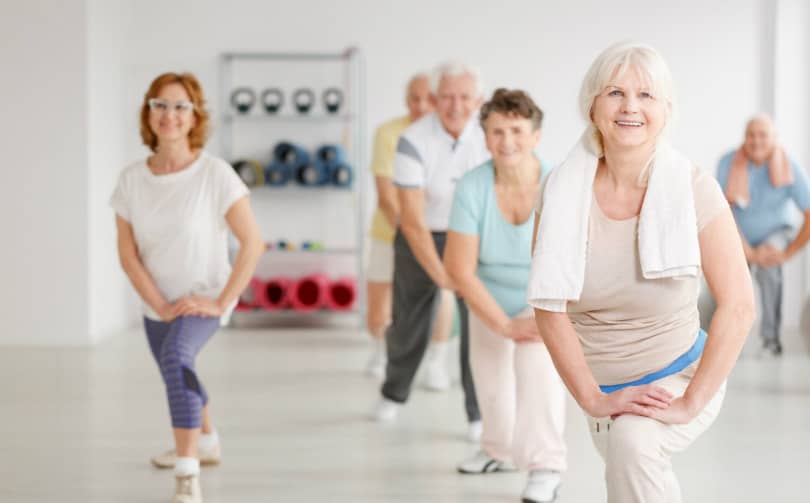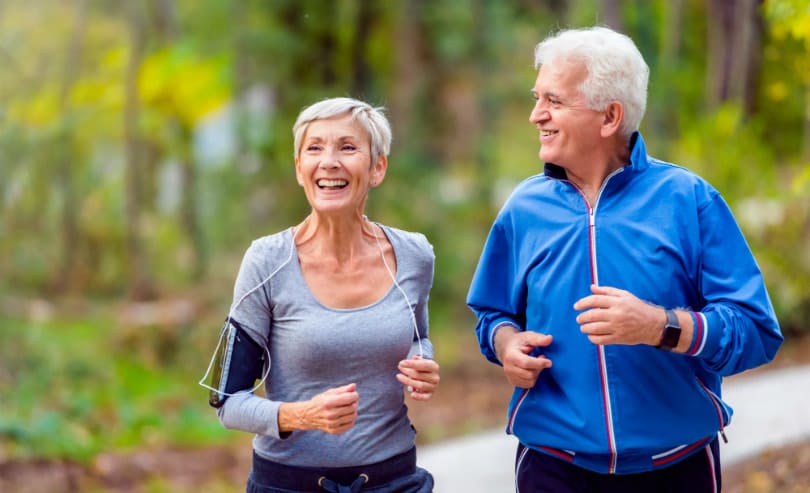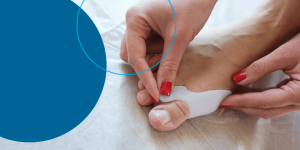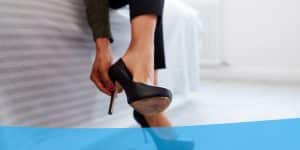There’s a simple “golden rule” when it comes to physical health:
Use it or lose it!
This rule applies to everybody, regardless of where they are in life. But it’s especially important for adults who are aging into their golden years.
While you can’t help getting older (and you will start to slow down sooner or later), regular physical activity can keep you a lot healthier, a lot happier, and a lot more mobile and independent for the next several years—or even decades!
But as you age, you may need to make some accommodations to your routine in order to continue exercising safely.
The Importance of Staying Active
Did you know that around 4 out of 5 adults over 50 suffer from at least one chronic condition? We’re talking things like diabetes, high blood pressure, chronic heel pain or back pain, etc.
Now, you can exercise every day and still develop a chronic condition, of course. But again, remember the golden rule—use it or lose it. If you don’t stay active, your risk of developing a chronic condition, or suffering a life-altering injury (such as a fall or diabetic wound) goes through the roof.
On the flipside, regular exercise offers huge benefits for aging adults:
- Maintain healthy weight and blood pressure—which greatly reduces your risk of chronic complications like diabetes, heart disease, and stroke.
- Stronger muscles, denser bones, and more flexible joints—which all greatly improve your mobility and reduce your risk of accidental injuries
- Greatly improved balance—so you’re less likely to fall. (More than a quarter of seniors fall each year, and about 1 in 5 falls result in serious injury or death.)
- Better sleep and even increased brain volume—meaning you stay cognitively sharper and are better able to make decisions and stay independent.
As a result of these and other benefits, exercising for just 3 hours per week may increase your expected lifespan by an average of 5 or more years, depending on your current age and health status.
And it won’t just be living longer, either—you’ll be enjoying a much higher quality of life, too.
Start Your Exercise Plan with a Few Essential Medical Checkups
One potential issue here: even under the best of circumstances, there may be some inherent risks to certain kinds of exercises that just weren’t present in your younger years. Bones are less dense. Muscles have less mass. Tendons aren’t quite as flexible as they once were.
While getting regular exercise is critical, an accidental fall or injury can undo a lot of progress—and maybe even discourage you from future activity.
So it’s important that you:
- Engage in safe, healthy exercise—appropriate for your age and physical conditions, with risk of accidental injury as low as possible.
- Choose activities or exercise plans that you are likely to stick with. Activity can be (and should be) fun! If you’re miserable, you’re probably going to quit.
Check in with Your Doctor
Just because one exercise plan is highly recommended on the Internet—or works for a friend, colleague, or spouse—doesn’t necessarily mean it’s the right one for you.
Your age, current health status, and other factors may influence which exercises will be most important for you, and how often you should practice them.
Talk to your GP about your physical health, any symptoms you’re experiencing, medications you are taking, etc. They will help you determine a safe, healthy exercise plan going forward, as well as preventative care steps you may need to take.
Check in with Your Podiatrist
Why see the podiatrist as well?
Remember that your feet aren’t just a random part of your body. They are your foundation. If your feet are hurting or unsteady, it makes it that much more difficult (if not completely impossible) to get the exercise you need safely. Even the daily tasks of independent living can become a massive challenge.
A podiatrist here at Foot & Ankle Surgical Associates is going to be your best choice for getting the foot attention you need. Benefits might include:
- Further advice on safe exercises, stretches, and activities to perform.
- Evaluation of your fall risk and foot and ankle biomechanics, and if necessary a prescription for custom orthotics, stability shoes, a balance brace, or other tools to keep you on your feet and pain free.
- Care for any existing foot deformities, heel pain, skin conditions, or other foot or ankle problems that are making it difficult for you to wear shoes or get healthy exercise.
- Preventative care for diabetic and neuropathic complications, which is essential if you want to reduce your risk of developing foot ulcers—which, if they get infected, can end up leading to amputation.

Further Tips for Exercising Safely and Consistently
Now, onto some more specific advice—but keep in mind, make sure you check in with your doctors first before starting your own plan
Aim for about 3 hours of moderate aerobic exercise per week.
You can think of that as about 30 minutes of exercise per day, 6 days per week. This is a good minimum that everybody should strive for—but of course, if you can do more, go for it! The important thing is to be consistent—a little every day is better than three hours on a Saturday and nothing the rest of the week.
Start slow.
So maybe 30 minutes a day isn’t doable for you right now. That’s okay. Listen to your body. Start with 10 minutes (or even 5) if you must. Doing too much, too soon (especially if you have been very sedentary) can lead to injury, but if you increase your intensity slowly and steadily you can eventually reach your goal.
Incorporate it into your daily tasks.
Daily chores can give you a decent workout—you don’t have to go to the gym or stop what you’re doing to get your daily aerobic exercise in! Housework, yardwork, and gardening are all great ways to stay active. If you can, try taking the “less convenient” route—for example, raking the yard or shoveling the driveway by hand, rather than using a leaf blower or snowblower.
Find sources of encouragement.
Many people find an easier time staying on track if they’re exercising with others. Having a spouse or friend with you on the journey can help you stay focused and motivated. You might also consider signing up for a local community fitness class or walking group.
What kinds of exercises should you be focused on? Make sure you regularly engage in:
Aerobic exercises.
In addition to the aforementioned yard or housework, this might include things like taking a nice brisk walk, going swimming, riding your bicycle, dancing, etc. Basically, you want to do things that increase your heart rate.
Strengthening exercises.
Weight training isn’t just for bodybuilders—it’s important for seniors, too! They will help you keep your bones and muscles strong and sturdy. You don’t need a gym membership, either—a set of hand weights and exercise bands can work wonders. Shoot for about two days a week of strengthening exercises.
Balance exercises.
Balance is another important safety and mobility skill that can be improved (and must be maintained) through practice. At home, you can practice your balance by standing on one foot (holding a chair or counter if necessary), or even just getting in and out of a chair without using your arms (if you can). You might also consider trying yoga or tai chi, at home or at a local studio. Do balance exercises at least three times per week—or even a little each day.
All that being said, we’ll remind you one more time—if you haven’t been exercising as much as you should and you’d like to change that, make sure you check in with us first. We will make sure you get the specific coaching, advice, and preventative treatment options you need to stay healthy while staying active—at any age.
To schedule an appointment at one of our offices, please call (360) 754-3338 today.





